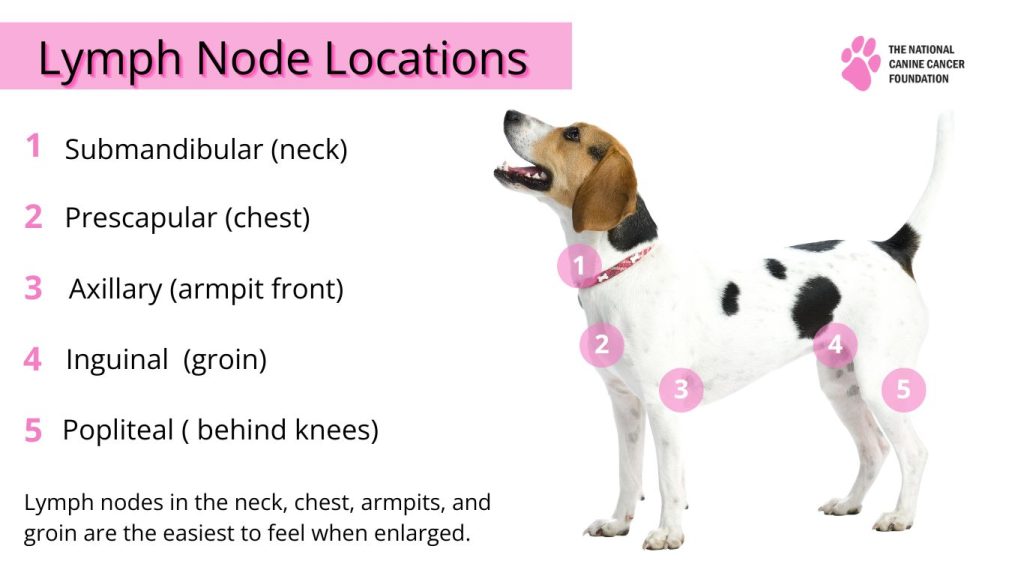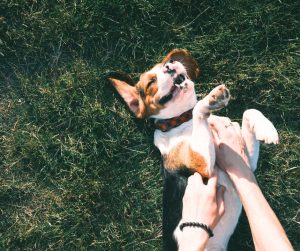Lymph nodes in dogs are an important part of their immune system. These small bean-shaped organs contain white blood cells that are ready and waiting to fight infections and other issues that can make your dog sick.
Unfortunately, dogs can develop lymphoma, which is cancer of the lymph nodes. To catch and possibly prevent this from occurring, it is important to check your dog’s lymph nodes once a month.
If you are wondering “where are lymph nodes in dogs?” you have come to the right place! Keep reading to learn where your dog’s lymph nodes are located, as well as tips on how to make checking them a relaxing experience for your pup.
Where are dog’s lymph nodes located?
The lymph nodes in dogs that you can feel through their fur and skin are in the:
- Lower jaw and neck
- Neck and shoulders
- Armpits
- Inside groin
- Back of the knee
There are other lymph nodes throughout your dog’s body too, but they can’t be felt from the outside.

How To Check Your Dog’s Lymph Nodes For Swelling
Because in a dog, swollen lymph nodes can be a sign of infection, inflammation, or other health issues, it is important to check your pup’s lymph nodes on a monthly basis. We Are the Cure suggests doing this once a month, on the same day if you can—for instance, on the 14th of the month. Doing this does not have to be stressful for you or your dog; in fact, most dogs will love the extra attention that you are giving them, as checking their lymph nodes is a lot like giving them a mini-massage or extra thorough petting.
Here’s how you can check your dog’s lymph nodes for swelling:
Familiarize yourself with the dog lymph node locations
As noted above, dogs have several lymph nodes in their body, but the ones you can feel the easiest are usually located behind the jaw, in front of the shoulder blades, in the groin area, and behind the knees. When you are petting your pup, familiarize yourself with the dog lymph node locations. Knowing these spots ahead of time will help you in the examination process and make it go as smoothly as possible.
Gently palpate the lymph nodes
- Submandibular lymph nodes (under the jaw): Start by gently feeling the area under your dog’s jaw on both sides. These lymph nodes are located just behind and beneath the jawbone.
- Prescapular lymph nodes (in front of the shoulder blades): Move your fingers to the area just in front of your dog’s shoulder blades, on both sides of the neck.
- Inguinal lymph nodes (groin area): Gently feel the area on both sides of your dog’s groin. These nodes are located in the inner thigh region.
- Popliteal lymph nodes (behind the knees): Finally, check behind your dog’s knees on both hind legs.
 Look for signs of swelling
Look for signs of swelling
While palpating each lymph node, pay attention to any signs of swelling, which can manifest as a lump or enlargement in the area. Swollen lymph nodes are often firm and feel like a grape just under the skin. If you notice any abnormalities or significant swelling, it’s important to consult your veterinarian and schedule a thorough examination.
Monitor for other signs
In addition to dog swollen lymph nodes, be aware of any other issues in your canine pal’s health, such as changes in appetite, behavior, energy level, or any other unusual symptoms. This information can be valuable when discussing your dog’s health with your veterinarian.
Check Your Dog Regularly
While it may be very worrisome to find that your dog has swollen lymph nodes, they can be caused by a number of conditions other than cancer. For instance, as PetMD notes, swollen lymph nodes in dogs can be caused by a number of conditions, including:
- Bacterial infections
- Fungal infections
- Demodectic mange
- Tick borne diseases
Also, some level of lymph node enlargement can be normal in dogs, especially if they’ve recently had vaccinations or have been exposed to infections.
 However, if you are concerned about any swelling or changes in your dog’s lymph nodes, it’s always best to consult your veterinarian for a professional evaluation and guidance on appropriate steps to take. If the tests do confirm that your dog has lymphoma, there are treatment options available.
However, if you are concerned about any swelling or changes in your dog’s lymph nodes, it’s always best to consult your veterinarian for a professional evaluation and guidance on appropriate steps to take. If the tests do confirm that your dog has lymphoma, there are treatment options available.
Since early detection is key for cancer treatment, it is important to check your dog’s lymph nodes once a month. This way, if you do feel something amiss, you can get your pup in for a vet’s appointment right away. By learning the locations of your dog’s lymph nodes and checking them regularly, you can definitely help your dog live a healthy and happy life.
To help stay on track with checking your dog’s lymph nodes and other important tasks related to your pup’s health, download our Dog Wellness Journal, purchase “Check Your Dog Cards,” and/or become a Core Member to help in the fight against canine cancer.
Other Articles of Interest:
Help Prevent Bladder Cancer in Dogs
Gastric carcinoma (stomach cancer) is a very common cancer in dogs
Dispelling the Myths and Misconceptions About Canine Cancer Treatment
Cancer Does Not Necessarily Mean A Death Sentence
Coming To Terms With Your Dog’s Cancer Diagnosis – You Are Not Alone


 Look for signs of swelling
Look for signs of swelling

This is a very important article, and I wish this would be brought up by every vet, technician, or other dog care professional. Maybe it could be incorporated into grooming as well. I have had three friends with dogs that had lymphoma. Maybe earlier detection could have improved treatment. I would like to write an article for my blog and refer to your article because it is so good. Advocacy for early detection needs to be moved to the forefront of every dog owner’s mind. Thank you
I had no idea I needed to check my dog’s lymph nodes or even where they were. Our trainer noticed her neck seemed swollen, so we got an appointment with the vet right away. Luckily, the tests came back quickly and we were able to see an oncologist the next week. By then, the rest of the nodes had gotten bigger. She just finished the CHOP protocol this August and so far is in remission.
Thank goodness! I am glad you got your dog in quickly and she was treated quickly!